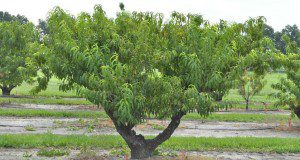Pears are a great tree to grow for an edible landscape or fruit garden. However, pears are not adapted to all areas in Florida, and only a few cultivated varieties will grow well here. An adaptation to warm winters (low chill hours) and disease resistance are the main factors for success. This new 6-page publication of the UF/IFAS Horticultural Sciences Department provides information to help homeowners select and grow pears successfully in Florida. Written by Juanita Popenoe, Ali Sarkhosh, and Dustin Huff.
https://edis.ifas.ufl.edu/hs1393
Tag: Dustin Huff
Cultivares de Caqui Japonés en Florida
El caqui japonés, Diospyros kaki L., es originario de China y fue cultivado por primera vez en Florida en el año 1870. El número de fincas productoras de caqui en Florida ha aumentado de 164 a 227 durante el período 2012-2017, haciendo mayor hincapié en la naturaleza de pequeña escala de la superficie promedio de fincas en esta industria. Los árboles crecen y fructifican mejor en el centro y norte de Florida, y pueden producir altos rendimientos de fruta de buena calidad. En el sur de Florida, la calidad de los frutos de tipo astringentes es mejor que la de los de tipo no astringentes.
This new 12-page article is the Spanish translation of SP101/MG242, Japanese Persimmon Cultivars in Florida. Written by Ali Sarkhosh, Peter C. Andersen, and Dustin Huff; translated by Jonathan Clavijo Herrera; and published by the UF/IFAS Horticultural Sciences Department.
https://edis.ifas.ufl.edu/mg460
Summer Pruning in Low-Chill Peaches Grown in Florida
Low-chill peach trees growing under Florida conditions can become vigorous and large. Summer pruning is a management strategy that can be applied to help restructure the canopy, direct the tree’s resources into fruit production, and improve the efficiency of fieldwork. Without summer pruning, peach orchards in subtropical regions will continue to grow vigorously and, if left unmanaged, will reach a point at which ladders will be required to harvest and maintain the trees. Summer pruning can be a means of reducing overall tree size, redistributing fruiting wood for easier harvesting, reducing disease pressure, and increasing fruit quality. This new 5-page publication of the UF/IFAS Horticultural Sciences Department, written by Ali Sarkhosh, Dustin Huff, Trequan McGee, and Juanita Popenoe, provides an illustrated step-by-step guide to summer pruning of peach trees.
https://edis.ifas.ufl.edu/hs1377


